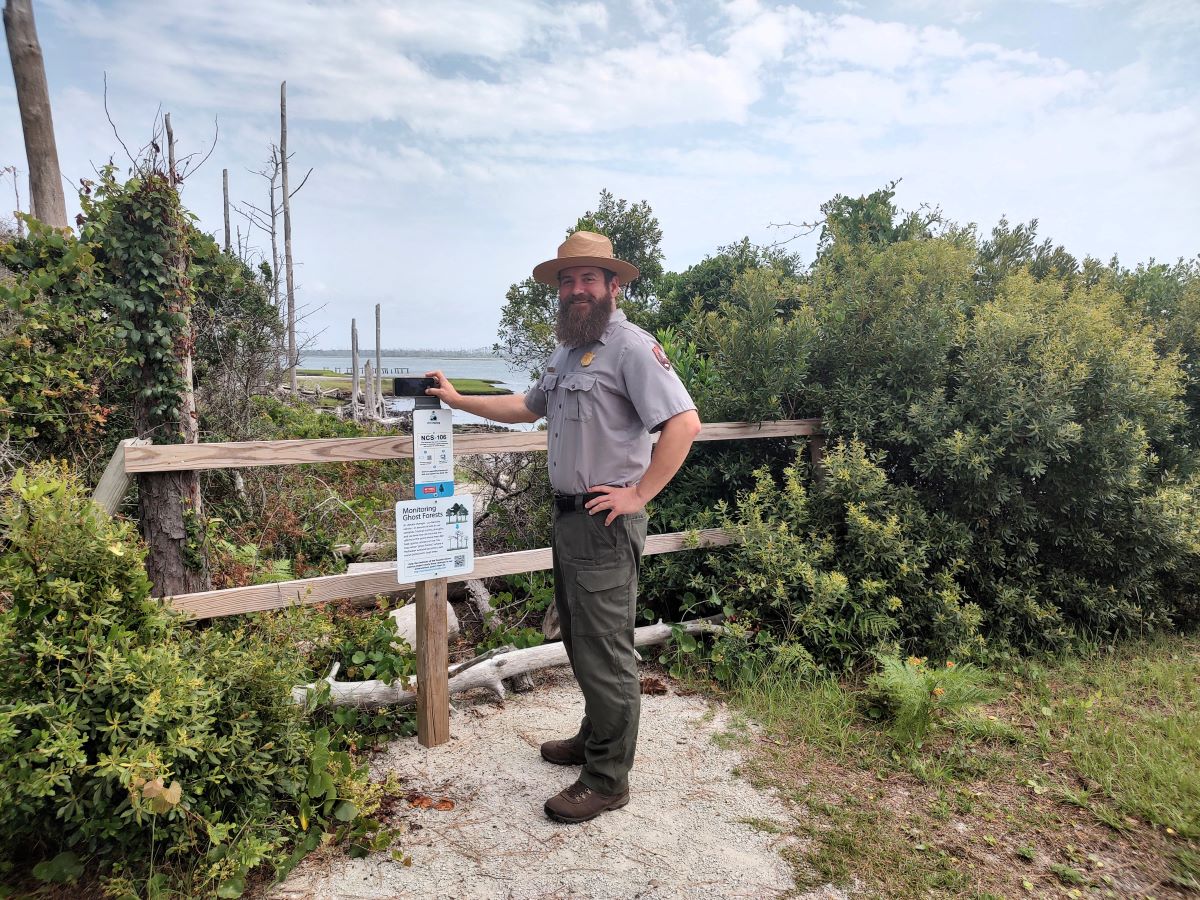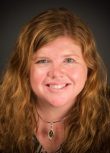
HARKERS ISLAND – About a quarter-mile along the Soundside Loop Trail behind Cape Lookout National Seashore’s visitor center is a two-board wooden fence, indicating that hikers need to make a sharp left turn to stay on the path.
In addition to guiding foot traffic on the 0.8-mile-long trail through maritime forest, the fence at the bend is where a new public science project called “Chronolog” was recently installed. The online tool helps track changes in the environment. In this case, the ghost forest on that side of the island.
Supporter Spotlight
When hikers walk by, they can place their smartphone in the gray bracket attached to the top of the fence post to align their photo, take the shot, then email it to Chronolog. Once received, the photo will be added to that location’s time-lapse almost immediately.
Chronolog houses crowd-sourced time-lapses of parks, nature centers, wildlife organizations, schools and museums. Currently, there are more than 500 Chronolog stations in 45 states. The Cape Lookout station is the 18th on the coast and there have been 10 submissions so far in the month since it was installed.
On a breezy morning in late June at the visitor center, Nate Toering, Cape Lookout’s chief of interpretation and education, explained that the Chronolog allows them to make informed decisions for managing that area of the park and provides “a better understanding of what’s going on in the environment around us.”
This Chronolog is part of a bigger project with the National Park Service, North Carolina State University and Core Sound Waterfowl Museum and Heritage Center. Four NC State undergraduate students worked with three mentors at the university on a ghost forest communication strategy for a senior-level course. The students wrote and designed a brochure as well as a “glideshow” that’s similar to a slideshow, called “Ghost Forests: The Dead Trees Down East.” Down East is a group of more than a dozen rural communities east of Beaufort.
Ghost forests occur when healthy coastal forests are repeatedly exposed to saltwater through high winds, tides or storms, making the plants, or trees, with low salt tolerance die off, eventually being replaced by salt marsh habitat.
Supporter Spotlight
From the Chronolog photo station down the trail, Toering pointed out the gradual transition of the dead trees that are rotting and breaking, but farther inland, there are super healthy trees.
He said that they’re finding at the National Seashore more salt-tolerant species in areas that didn’t have salt-tolerant species before, and are interested in observing the growth of the ghost forest and potential erosion in that area.
Jutting past the ghost forest, several yards away from the existing station, are the jagged remnants of a walkway across a salt marsh that had been destroyed by Hurricane Florence in 2018.
Toering said there are plans to rebuild the walkway, hopefully by the end of the year. When that build is complete, there will be a second Chronolog installed looking toward the ghost forest in the direction of the existing Chronolog, to provide a panoramic view.

Long term, especially after the second Chronolog is installed, there will be a more site-specific assessment of the growth of the ghost forest, such as how fast an area that used to be a forest is transitioning into salt marsh, he explained.
Toering said that as a ranger, he provides frontline messaging on ghost forests and encourages visitors to participate in this public science project. Adding, he’s trying to get people engaged, more knowledgeable about their environment and more caring about what’s going on around them. “Because one way or another, it impacts all of us.”
Part of that frontline messaging is providing to visitors the brochure, “Ghost Forests: What are they and how can you spot one?” that the NC State students designed for their senior course, called a capstone project.
Dr. Erin Seekamp, distinguished professor of resilience and sustainability and director of the Coastal Resilience and Sustainability Initiative at NC State, coordinated the project.
Seekamp has been working with the Down East community since 2015 on adaptation planning for Cape Lookout’s historic districts, and had discussed with Core Sound Museum and Heritage Center Executive Director Karen Willis Amspacher that ghost forests are a good indicator of the vulnerabilities in these communities.
When Seekamp was approached by a colleague to design a capstone project for the interdisciplinary degree, environmental sciences, she said she immediately connected the two.

Serving as community liaison, Seekamp brought in as a ghost forest expert for the project Department of Forestry and Environmental Resources associate professor Dr. Marcelo Ardón, who has been behind installing Chronologs on the coast, and science communicator Michelle Jewell with the Department of Applied Ecology and president of the Science Communicators of North Carolina.
Seekamp said that this project helps students recognize how applied science is important, and integrating that with community engagement. Engaging students in the process of observation opens the door to being more aware of your environment and watching change, as well as using science to understand the changes that are occurring.
The idea is to grow the project in future semesters. “We really want to embed the next phases to include integration of schools and that intergenerational learning component,” with parents and grade-school students, and have further conversations about the future and adaptation, Seekamp said.
Amspacher said Core Sound is dedicated to learning and sharing more about the changing environment along the coast and especially Down East.
“Partnering with NC State and other universities has opened doors for us to be involved with the important research taking place around us. We are very thankful to bring the community into this conversation. We look forward to working with local students to use this Chronolog project as a way to increase their — and their families’ — understanding of how saltwater is already impacting our landscape.”
Students on the project were Rachel DeChicio, Andrew Barfield, Jordan Strickland and Arden Lumpkin, who each graduated this year with a bachelor’s in environmental sciences.
DeChicio told Coastal Review that one of her biggest takeaways from this project is how important it is to focus on a community’s culture and values when communicating about climate change topics such as saltwater intrusion and ghost forests.
“Harkers Island has an amazing community that loves their home and has deep ties to the land, so it is important to create educational materials on climate change that inspire curiosity and not fear,” DeChicio said. “I hope people who visit the Core Sound Waterfowl Museum and Heritage Center are able to learn a little bit about saltwater intrusion and ghost forests from our products, and are then able to identify why their coastal forests are dying. I hope seeing the formation of ghost forests on Harkers Island and having the knowledge to name that occurrence empowers people to learn more about combating climate change.”
Barfield added that he learned through this project how ghost forests are a very visible aspect of our changing climate.
“It is my hope that ghost forests can be used as a tool to further educate the public on the many ways that our world around us is changing. The more involvement that we get from local communities, then the better chance we have of adapting to these changes moving forward,” Barfield said.
Strickland said in an email that the two main things he learned while working on this project are the technicalities of designing and developing science communication products and ghost forests in general.
“One of the main reasons why I chose this project as my top pick when we were deciding teams, was because I never heard of the term ‘ghost forests’ before,” he said. “Of course, I knew they were not referring to an actual haunted forest, so it intrigued me.”
After learning what ghost forests are, and how they have begun to spread on the coast of Harkers Island, he said he wanted to help provide the community with information about what ghost forests indicate.
“I knew if me, as an environmental science major, didn’t know much about ghost forests, then that means most of the general public doesn’t as well. Ghost forests are not only an indication of climate change and sea level rise, but also foreshadow how our coastal forests could end up as these two factors continue to impact the NC coast in the coming years,” Strickland added.
Lumpkin said the project taught her the importance of properly communicating climate science through the lens of who it impacts. The ghost forests that are popping up and growing quickly along the coast of these Down East communities are a tangible example of the effects of sea level rise and saltwater intrusion. Viewing this issue through the eyes of a community member gives you a wider perspective on the best way to communicate it.
“The Down East community has a rich, generational history and connection with their land and have persevered in the face of many challenges,” she said. “My biggest hope with our project is that it will spark curiosity and conversation about climate change among the community. The Core Sound Waterfowl Museum is such an important place visited frequently by residents and I hope that our project can, at the least, be the start of a conversation about climate change impacts.”
Jewell explained to Coastal Review that this type of class project works all the way around: “The community’s needs are heard and answered, the students receive training and experience in co-creation and science communication, and the researchers will get more data from this changing landscape. Truly encapsulating the N.C. State mission of research, teaching, and extension.”
Science communication is an iterative process, and the hope is that this piece is the first of many touchpoints, Jewell said. “Our aim is to create a space for community members to engage with the changes happening around them. And that engagement can come in many forms,” from submitting photos at the Chronolog site, to being able to identify and understand ghost forests.

The Chronolog station on Harkers Island is one of the nearly 20 that Ardón with NC State has either installed or helped coordinate the installation along the coast.
He said in an interview that the idea to have the public help monitor ghost forests dates back a few years and was asking the public to submit photos through an online platform before discovering Chronolog while on vacation on Bald Head Island.
Chronolog’s process appealed to Ardón. Rather than photos being submitted from all over, have the public take photos of the same location to make tracking the changes easier to observe.
He explained that these forests and marshes change on the scales of decades to centuries, but they’re probably changing a lot faster, on the scales of years to decades, “but that’s still pretty slow for us to see on a regular basis. I think the idea was if we have these photographs, then maybe it’ll become a little bit easier to see the change of these ecosystems.”

Ardón said in addition to looking at change over time, he wants to use the photos to study how the seasons change the landscape.
With a grant through the National Science Foundation, Ardon began in 2021 installing Chronolog stations at Goose Creek State Park, Pocosin Lakes National Wildlife Refuge, Alligator River National Wildlife Refuge, E. Merle Waterfowl Impoundment, and Swan Quarter National Wildlife Refuge.
After installing the first round, he said N.C. Department of Natural and Cultural Resources officials liked the project and decided to fund 11 more stations. He worked with the site managers to determine the best location for each Chronolog, depending on what they wanted to document, such as a marsh or a living shoreline.
“For the ghost forests, I’m really interested in looking at how long the snags, the standing dead trees, actually last, because there’s been some studies of those snags but there’s not a lot of good fine-scaled information of: How often do they fall over? Is it just after big storms? Is it small storms? Is it just after time that eventually they fall over? So those are the kinds of questions that I want to answer with these stations,” he said.







